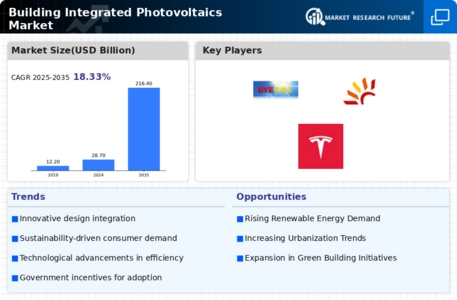Top Industry Leaders in the Building Integrated Photovoltaics Market

*Disclaimer: List of key companies in no particular order
The global Building Integrated Photovoltaics (BIPV) market is undergoing substantial growth, propelled by factors such as escalating energy costs, governmental incentives for renewable energy adoption, and an increasing awareness of sustainability. This thriving market has attracted a diverse array of players, resulting in a highly competitive landscape. This article delves into the competitive dynamics of the BIPV market, examining key player strategies, factors influencing market share, emerging trends, and the overall competitive scenario.
Key Player Strategies: Key players in the BIPV market include Scheuten Solar (The Netherlands), Wurth Solar (Germany), Dow Solar (US), Suntench Power (China), Belectric (Germany), Carmanah Technologies Corporation (Canada), Dyesol Ltd. (Australia), Hanergy Holding Group Limited (China), Ertex Solartechnik GmbH (Germany), Canadian Solar Inc. (Canada), Tesla Inc. (US), NanoPV Solar Inc. (US), Solaria Corporation (US), ML System (Poland), and others.
-
Product Diversification: Leading players are heavily investing in research and development to create a diversified portfolio of BIPV solutions that cater to various applications and building types. This includes thin-film technologies, BIPV facades, and roof-integrated systems.
-
Strategic Partnerships and Acquisitions: Companies are actively pursuing strategic partnerships and acquisitions to expand their geographic reach, access new technologies, and strengthen their market presence. This trend is anticipated to persist, further heightening competition.
-
Vertical Integration: Some players are adopting a vertical integration strategy by acquiring manufacturing capabilities and controlling the entire supply chain. This approach helps them achieve cost efficiencies and improve product quality.
-
Focus on Sustainability: With growing environmental concerns, players are emphasizing the sustainability credentials of their BIPV solutions. This involves sourcing renewable materials, implementing green manufacturing practices, and focusing on low-carbon footprints.
-
Digitalization and Innovation: Companies are embracing digitalization by utilizing technologies like Building Information Modeling (BIM) and the Internet of Things (IoT) to optimize the design, installation, and maintenance of BIPV systems. Additionally, they are investing in innovative technologies like Perovskite solar cells to enhance efficiency and aesthetics.
Factors for Market Share Analysis: Several critical factors influence a company's market share in the BIPV market, including:
-
Product Portfolio: The breadth and depth of a player's BIPV product portfolio significantly impact market share. Companies offering a diverse range of solutions for various applications are better positioned to capture a larger market share.
-
Brand Recognition and Reputation: Established brands with strong reputations for quality and reliability have a significant advantage in the competitive landscape.
-
Geographical Reach: Companies with a wider geographical presence can access a larger market and achieve a higher market share.
-
Manufacturing Capabilities and Cost Efficiency: Efficient manufacturing processes and cost-competitive pricing are crucial for players to gain an edge in the market.
-
Technical Expertise and Innovation: Companies with a strong track record of innovation and expertise in BIPV technology are well-positioned to capture market share.
-
Customer Service and Support: Offering excellent customer service and responsive support is essential for building long-term customer relationships and securing market share.
New and Emerging Trends: Several emerging trends are shaping the future of the BIPV market:
-
Smart BIPV Systems: Integration of BIPV with smart technologies like energy management systems and data analytics platforms is gaining traction. This enables real-time performance monitoring, data-driven decision-making, and optimal energy consumption.
-
Building-as-a-Service (BaaS) Models: Emerging business models like BaaS offer innovative financing options for BIPV installations, making them more accessible to a wider range of customers.
-
Integration with Building Materials: BIPV is increasingly being integrated with building materials like windows, claddings, and roofing tiles, creating aesthetically pleasing and energy-efficient building envelopes.
-
Customization and Design Flexibility: Players are focusing on offering customized BIPV solutions that cater to specific aesthetic and functional requirements of different buildings, expanding design possibilities.
-
Focus on Emerging Markets: With growing awareness of BIPV benefits and supportive government policies, emerging markets are expected to witness significant growth in the coming years, attracting major players to expand their presence in these regions.
As the market matures, we can expect further consolidation through mergers and acquisitions, as well as the emergence of new technologies and business models. Players who can adapt to these changing dynamics and offer innovative, cost-effective, and sustainable BIPV solutions will be well-positioned to thrive in the competitive landscape.
The BIPV market is on a promising trajectory, driven by favorable market trends and increasing adoption of renewable energy solutions. The competitive landscape is dynamic and diverse, with players constantly evolving their strategies to gain an edge. By focusing on product diversification, innovation, sustainability, and customer-centric approaches, companies can navigate the competitive landscape and contribute to the growth of the BIPV market.
Industry Developments and Latest Updates:
- Scheuten Solar (Netherlands): October 26, 2023: Launched new "Skylight Power Tile" BIPV product for residential rooftops, offering both energy generation and improved aesthetics. (Source: Scheuten Solar press release)
- Wurth Solar (Germany): December 7, 2023: Secured a major BIPV contract for a new office building in Munich, Germany. (Source: Solar Power Europe website)
- Dow Solar (US): October 20, 2023: Unveiled a new BIPV solution specifically designed for integration with metal roofing systems. (Source: Dow Chemical website)
- Belectric (Germany): December 5, 2023: Completed installation of a large BIPV roof system on a logistics center in France. (Source: Belectric website)
- Carmanah Technologies Corporation (Canada): December 8, 2023: Announced successful deployment of BIPV lighting system for a remote community school in British Columbia. (Source: Cleantech Canada website)

